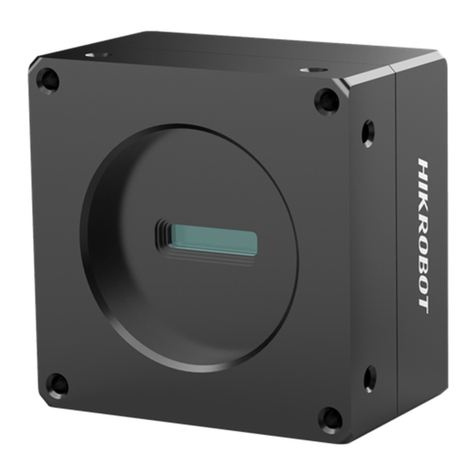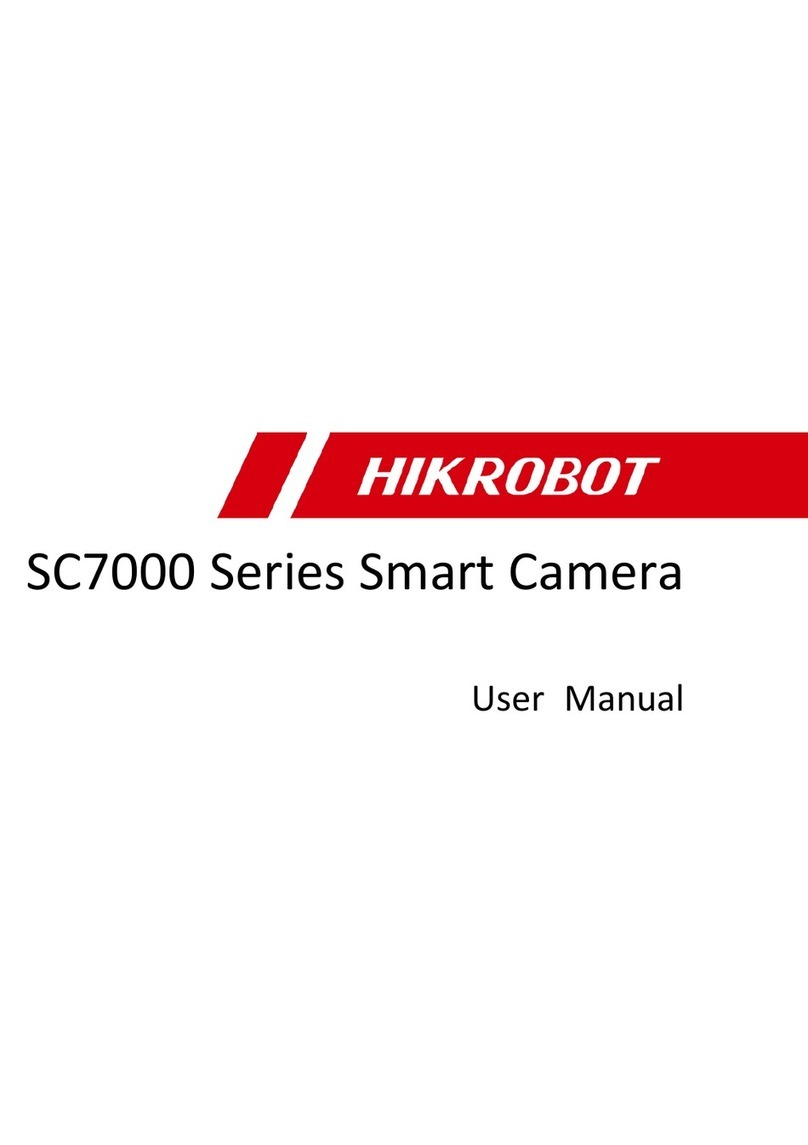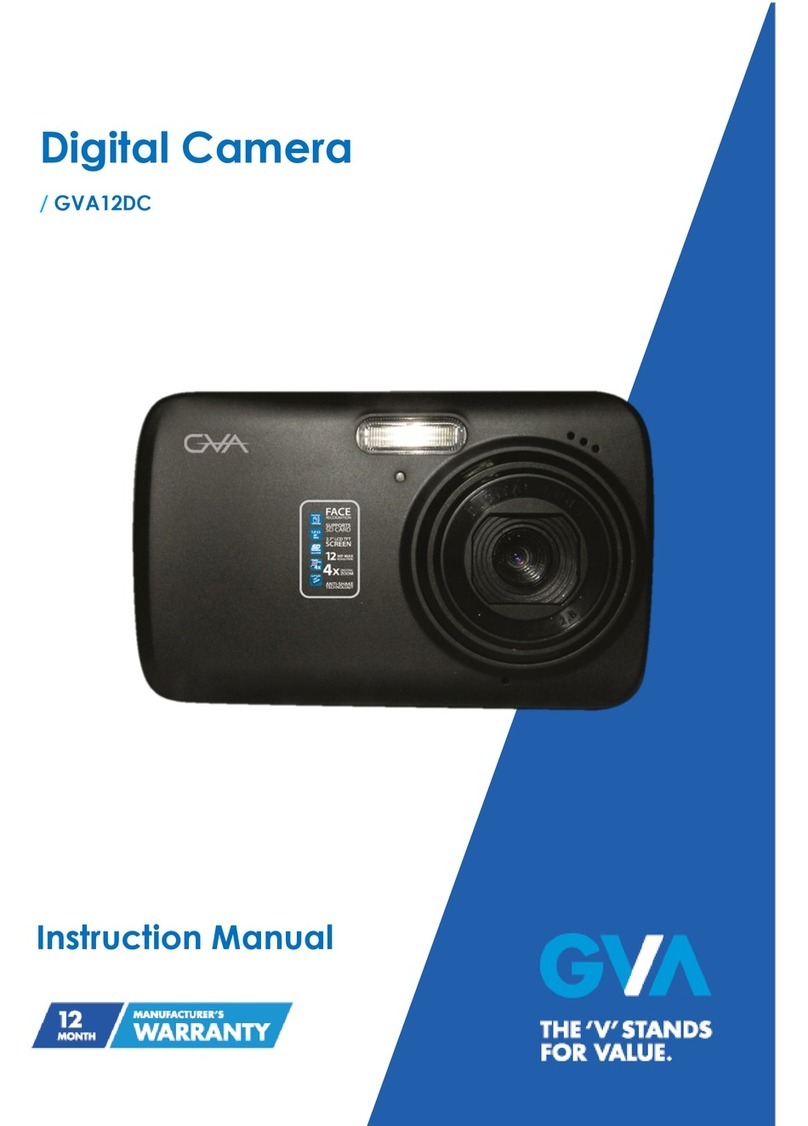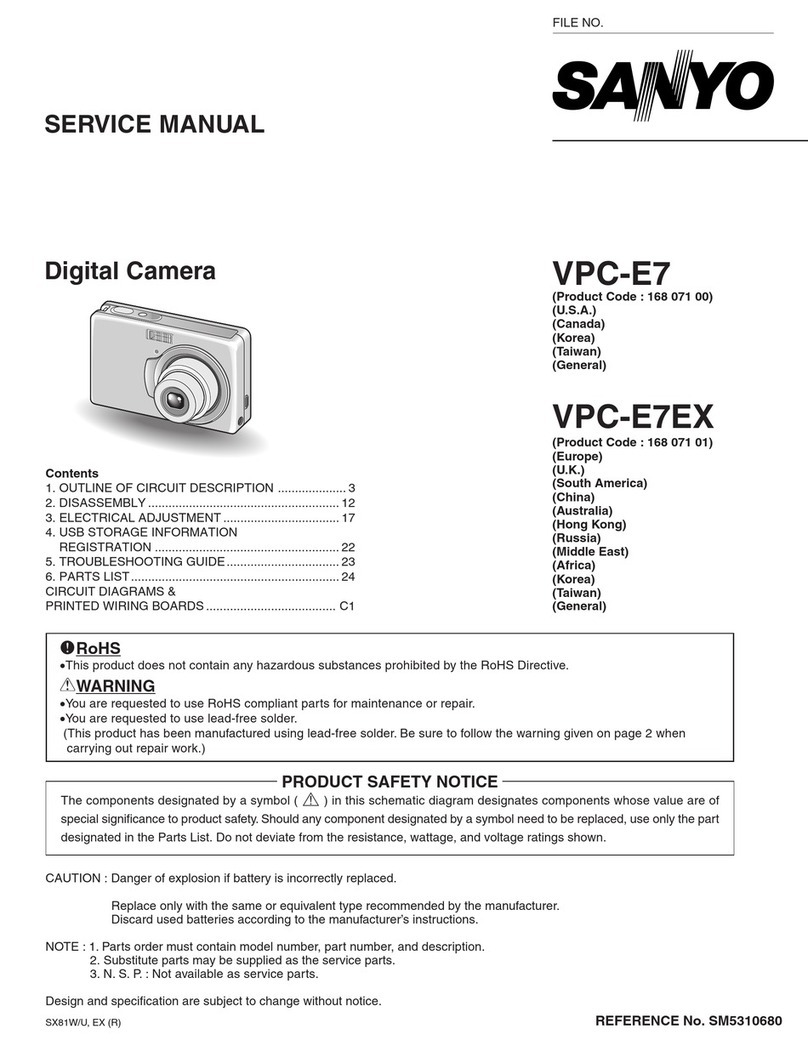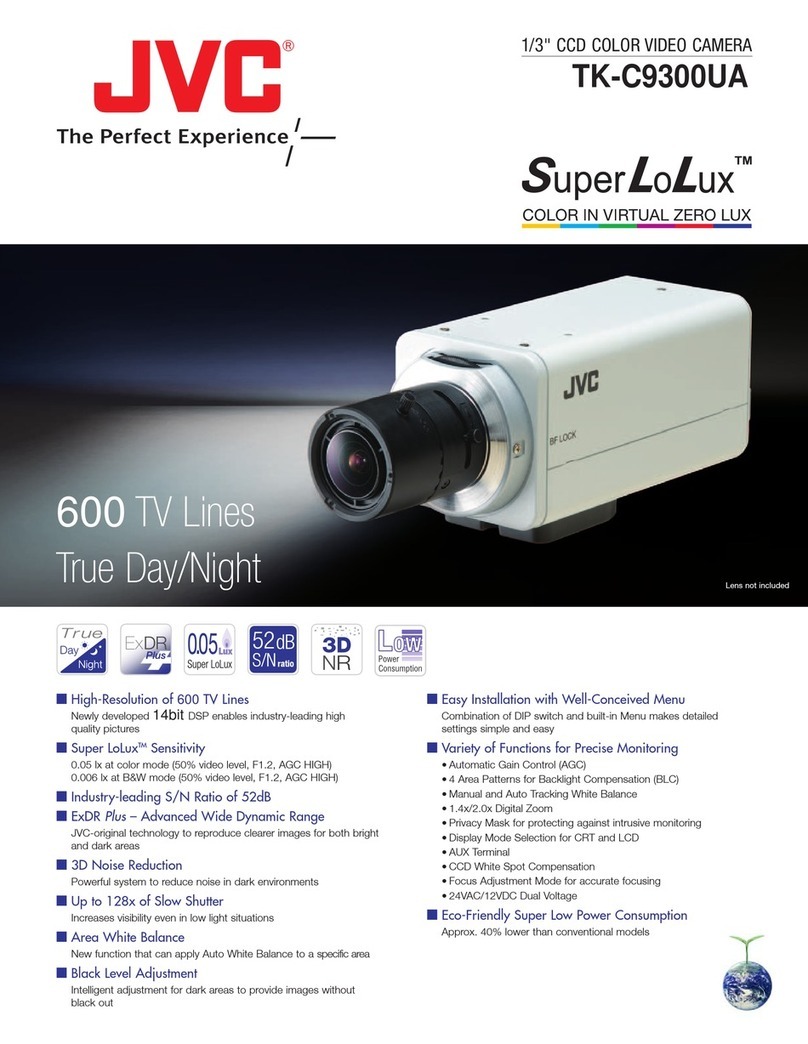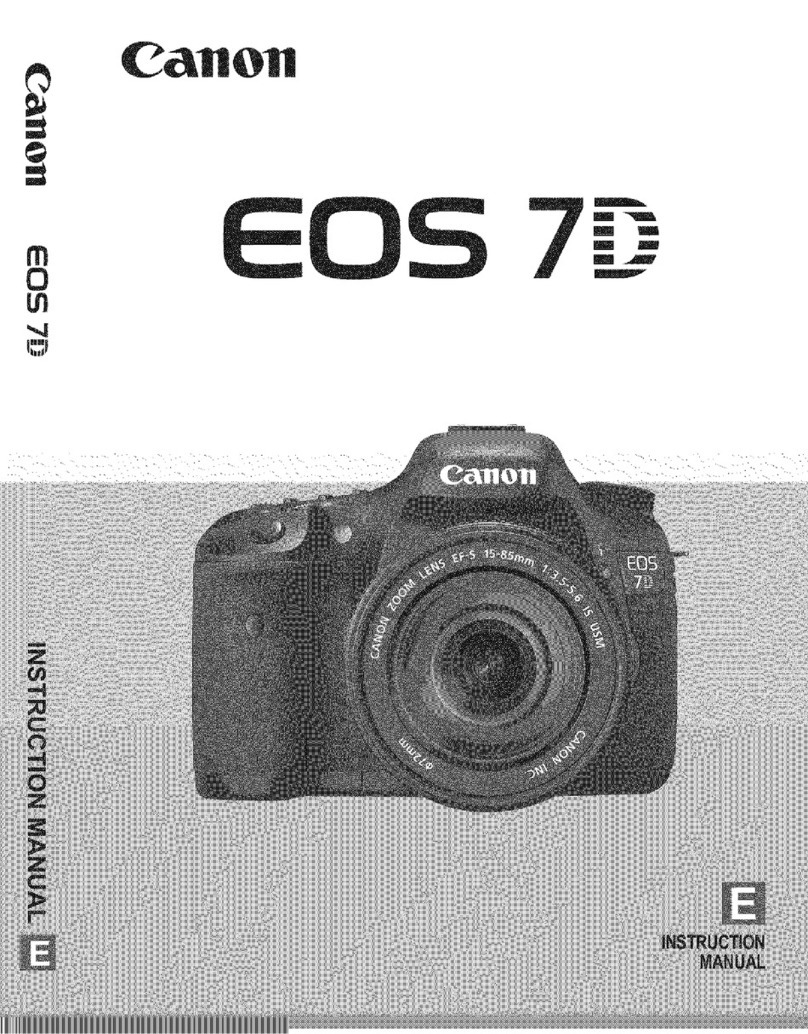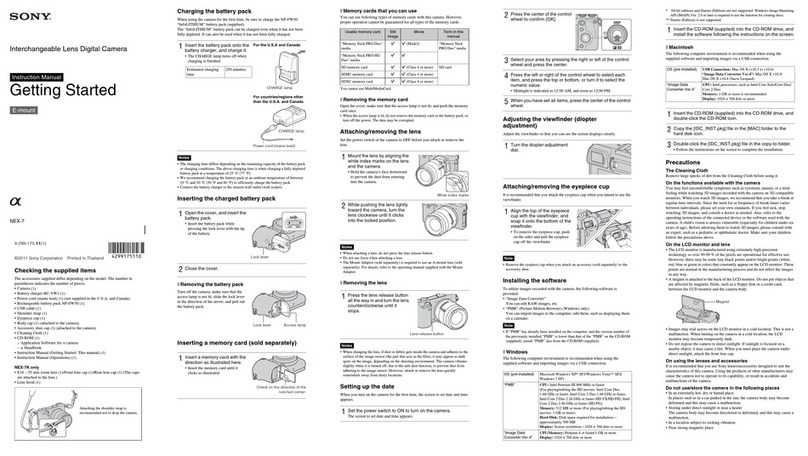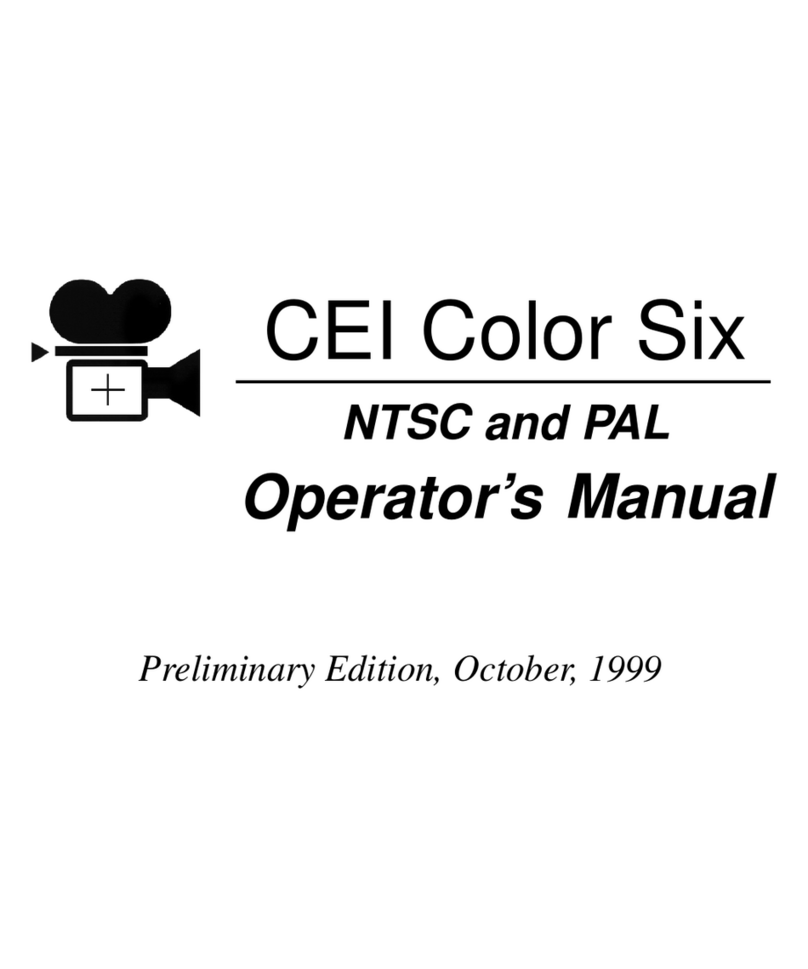HikRobot GigE User manual

GigE Line Scan Camera
User Manual

GigE Line Scan Camera User Manual
i
Legal Information
© 2023 Hangzhou Hikrobot Co., Ltd. All rights reserved.
About This Manual
The Manual includes instructions for using and managing the Product. Pictures, charts,
images and all other information hereinafter are for description and explanation only. The
information contained in the Manual is subject to change, without notice, due to firmware
updates or other reasons. Please find the latest version of this Manual at the Hikrobot
website (https://en.hikrobotics.com/). Please use this Manual with the guidance and
assistance of professionals trained in supporting the Product.
Trademarks
and other Hikrobot's trademarks and logos are the properties of
Hikrobot in various jurisdictions. Other trademarks and logos mentioned are the properties
of their respective owners.
Disclaimer
TO THE MAXIMUM EXTENT PERMITTED BY APPLICABLE LAW, THIS MANUAL AND THE
PRODUCT DESCRIBED, WITH ITS HARDWARE, SOFTWARE AND FIRMWARE, ARE
PROVIDED "AS IS" AND "WITH ALL FAULTS AND ERRORS". HIKROBOT MAKES NO
WARRANTIES, EXPRESS OR IMPLIED, INCLUDING WITHOUT LIMITATION,
MERCHANTABILITY, SATISFACTORY QUALITY, OR FITNESS FOR A PARTICULAR
PURPOSE. THE USE OF THE PRODUCT BY YOU IS AT YOUR OWN RISK. IN NO EVENT WILL
HIKROBOT BE LIABLE TO YOU FOR ANY SPECIAL, CONSEQUENTIAL, INCIDENTAL, OR
INDIRECT DAMAGES, INCLUDING, AMONG OTHERS, DAMAGES FOR LOSS OF BUSINESS
PROFITS, BUSINESS INTERRUPTION, OR LOSS OF DATA, CORRUPTION OF SYSTEMS, OR
LOSS OF DOCUMENTATION, WHETHER BASED ON BREACH OF CONTRACT, TORT
(INCLUDING NEGLIGENCE), PRODUCT LIABILITY, OR OTHERWISE, IN CONNECTION WITH
THE USE OF THE PRODUCT, EVEN IF HIKROBOT HAS BEEN ADVISED OF THE POSSIBILITY
OF SUCH DAMAGES OR LOSS.
YOU ACKNOWLEDGE THAT THE NATURE OF INTERNET PROVIDES FOR INHERENT
SECURITY RISKS, AND HIKROBOT SHALL NOT TAKE ANY RESPONSIBILITIES FOR
ABNORMAL OPERATION, PRIVACY LEAKAGE OR OTHER DAMAGES RESULTING FROM
CYBER-ATTACK, HACKER ATTACK, VIRUS INFECTION, OR OTHER INTERNET SECURITY
RISKS; HOWEVER, HIKROBOT WILL PROVIDE TIMELY TECHNICAL SUPPORT IF REQUIRED.
YOU AGREE TO USE THIS PRODUCT IN COMPLIANCE WITH ALL APPLICABLE LAWS, AND
YOU ARE SOLELY RESPONSIBLE FOR ENSURING THAT YOUR USE CONFORMS TO THE
APPLICABLE LAW. ESPECIALLY, YOU ARE RESPONSIBLE, FOR USING THIS PRODUCT IN A
MANNER THAT DOES NOT INFRINGE ON THE RIGHTS OF THIRD PARTIES, INCLUDING
WITHOUT LIMITATION, RIGHTS OF PUBLICITY, INTELLECTUAL PROPERTY RIGHTS, OR
DATA PROTECTION AND OTHER PRIVACY RIGHTS. YOU SHALL NOT USE THIS PRODUCT
FOR ANY PROHIBITED END-USES, INCLUDING THE DEVELOPMENT OR PRODUCTION OF
WEAPONS OF MASS DESTRUCTION, THE DEVELOPMENT OR PRODUCTION OF
CHEMICAL OR BIOLOGICAL WEAPONS, ANY ACTIVITIES IN THE CONTEXT RELATED TO

GigE Line Scan Camera User Manual
ii
ANY NUCLEAR EXPLOSIVE OR UNSAFE NUCLEAR FUEL-CYCLE, OR IN SUPPORT OF
HUMAN RIGHTS ABUSES.
THE PERFORMANCE DATA IN THIS PUBLICATION IS BASED ON HIKROBOT'S INTERNAL
RESEARCH/EVALUATION. ACTUAL DATA MAY VARY DEPENDING ON SPECIFIC
CONFIGURATIONS AND OPERATING CONDITIONS AND HIKROBOT SHALL NOT BEAR THE
CONSEQUENCES ARISING THEREFROM.
IN THE EVENT OF ANY CONFLICTS BETWEEN THIS MANUAL AND THE APPLICABLE LAW,
THE LATTER PREVAILS.
Regulatory Information
Note
These clauses apply only to the products bearing the corresponding mark or information.
FCC Information
Please take attention that changes or modification not expressly approved by the party
responsible for compliance could void the user’s authority to operate the equipment.
FCC Compliance
This equipment has been tested and found to comply with the limits for a Class A digital
device, pursuant to part 15 of the FCC Rules. These limits are designed to provide
reasonable protection against harmful interference when the equipment is operated in a
commercial environment. This equipment generates, uses, and can radiate radio
frequency energy and, if not installed and used in accordance with the instruction manual,
may cause harmful interference to radio communications. Operation of this equipment in
a residential area is likely to cause harmful interference in which case the user will be
required to correct the interference at his own expense.
FCC Conditions
This device complies with part 15 of the FCC Rules. Operation is subject to the following
two conditions:
●This device may not cause harmful interference.
●This device must accept any interference received, including interference that may
cause undesired operation.
EU Conformity Statement
This product and - if applicable - the supplied accessories too are
marked with "CE" and comply therefore with the applicable
harmonized European standards listed under the Directive
2014/30/EU(EMCD),Directive 2001/95/EC(GPSD) and Directive
2011/65/EU(RoHS).
2012/19/EU (WEEE directive): Products marked with this symbol
cannot be disposed of as unsorted municipal waste in the European
Union. For proper recycling, return this product to your local supplier

GigE Line Scan Camera User Manual
iii
upon the purchase of equivalent new equipment, or dispose of it at
designated collection points. For more information see:
http://www.recyclethis.info
2006/66/EC (battery directive): This product contains a battery that
cannot be disposed of as unsorted municipal waste in the European
Union. See the product documentation for specific battery
information. The battery is marked with this symbol, which may
include lettering to indicate cadmium (Cd), lead (Pb), or mercury (Hg).
For proper recycling, return the battery to your supplier or to a
designated collection point. For more information see:
http://www.recyclethis.info
Warning: This is a class A product. In a domestic environment this product may cause
radio interference in which case the user may be required to take adequate measures.
KC Mark Certification
Class A: The device is advised to note that as a seller or a business user (Class A) Devices
and intended for use outside the Home area.
A급기기: 이기기는 업무용(A급) 전자파적합기기로써 판매자 또는 사용자는 이점을
주의하시기바라며, 가정 외의 지역에서 사용하는 것을 목적으로 합니다.
Symbol Conventions
The symbols that may be found in this document are defined as follows.
Symbol
Description
Danger
Indicates a hazardous situation which, if not avoided, will or
could result in death or serious injury.
Caution
Indicates a potentially hazardous situation which, if not avoided,
could result in equipment damage, data loss, performance
degradation, or unexpected results.
Note
Provides additional information to emphasize or supplement
important points of the main text.
Available Model
This manual is applicable to the GigE line scan camera.
Safety Instruction
These instructions are intended to ensure that the user can use the device correctly to
avoid danger or property loss.
●Read and follow these safety instructions before installing, operating and maintaining
the device.
●To ensure personal and device safety, when installing, operating, and maintaining the

GigE Line Scan Camera User Manual
iv
device, follow the signs on the device and in the manual, and all safety instructions
described in the manual.
●The note, warning and danger items in the manual do not represent all the safety
instructions that should be observed, but only serve as a supplement to all the safety
instructions.
●The device should be used in an environment that meets the design specifications,
otherwise it may cause malfunctions, and malfunctions or component damage caused
by non-compliance with relevant regulations are not within the scope of the device's
quality assurance.
●Our company will not bear any legal responsibility for personal safety accidents and
property losses caused by abnormal operation of the device.
Caution:
●In the use of the device, you must be in strict compliance with the electrical safety
regulations of the nation and region.
●Use the power adapter provided by the official manufacturer, and the power supply
should meet LPS or PS2 requirements according to IEC 60950-1 or IEC 62368-1
standard. For the specific requirements of the power adapter, please refer to the
device’s specifications.
●To reduce the risk of fire or electric shock, do not expose the device to rain or moisture.
●Make sure that the device is firmly fixed when installing it in the use environment.
●If the device does not work properly, please contact your dealer or the nearest service
center. Never attempt to disassemble the device yourself (we shall not assume any
responsibility for problems caused by unauthorized repair or maintenance).
●Avoid installing the device in a vibration or shock environment, and keep it away from
electromagnetic interference sites (ignoring this may damage the device).
●Do not directly touch the heat dissipation parts of the device to avoid burns.
●Do not install the indoor device in an environment where it may be exposed to water or
other liquids.
●Do not use the device in high temperature, low temperature or high humidity
environment. For specific temperature and humidity requirements, please refer to the
device’s specifications.
●Avoid aiming the lens at strong light (such as lighting, sunlight, or laser beams, etc.),
otherwise the image sensor will be damaged.
●Do not touch the image sensor directly. If cleaning is necessary, please slightly dampen
a soft clean cloth with alcohol and gently wipe off the dust. When the device is not in
use, please attach a dust cover to protect the image sensor.
Personnel Requirement
Quality requirements for installation and maintenance personnel: Qualification certificate
or working experience in weak current system installation and maintenance, and relevant
working experience and qualifications. Besides, the personnel must possess the following
knowledge and operation skills:
●The basic knowledge and operation skills of low voltage wiring and low voltage

GigE Line Scan Camera User Manual
v
electronic circuit connection.
●The ability to comprehend the contents of this manual.
Electromagnetic Interference Prevention
●When installing the device, if you cannot ensure that the device itself and all equipment
connected to the device are well grounded, you should isolate the device with an
insulating bracket.
●To avoid the accumulation of static electricity, ensure that other equipment (such as
machines, internal components, etc.) and metal brackets on site are properly grounded.
●The power cable, data cable, signal cable, etc. of the device must be wired separately.
Make sure to ground them if the wiring groove is used to separate the wiring and the
wiring groove is metal.
●During the installation and use of the device, high voltage leakage must be avoided.
●Use a figure-eight bundle method if the device cable is too long.
●Do not route the device together with other equipment (especially servo motors,
high-power devices, etc.), and control the distance between cables to more than 10 cm.
Make sure to shield the cables if unavoidable.
●The control cable of the device and the power cable of the industrial light source must
be wired separately to avoid bundled wiring.
●When connecting the device and metal accessories, they must be connected firmly to
maintain good conductivity.
●Use a shielded network cable to connect to the device. If you use a self-made network
cable, make sure that the shielding shell at the aviation head is well connected to the
aluminum foil or metal braid of the shielding cable.
●During the wiring process, evaluate the wiring space reasonably, and do not pull the
cables hard, so as not to damage the electrical performance of the cables.
●The unused cables of the device must be insulated.
●Use the power adapter to supply power to the device separately. If centralized power
supply is necessary, make sure to use a DC filter to filter the power supply of the device
separately before use.
●If the device is powered on and off frequently, it is necessary to strengthen the voltage
isolation, and consider adding a DC/DC isolation power supply module between the
device and the adapter.
Contact Information
Hangzhou Hikrobot Co., Ltd.
E-mail: tech_support@hikrobotics.com
Website: https://en.hikrobotics.com/

GigE Line Scan Camera User Manual
vi
Contents
Chapter 1 Overview...........................................................................................................................1
1.1 Introduction .........................................................................................................................1
1.2 Key Feature..........................................................................................................................1
Chapter 2 Appearance......................................................................................................................2
Chapter 3 I/O Connector and Indicator..........................................................................................3
3.1 Power and I/O Connector..................................................................................................3
3.2 Indicator...............................................................................................................................5
Chapter 4 Installation .......................................................................................................................6
4.1 Installation Preparation.....................................................................................................6
4.2 Install Device .......................................................................................................................6
Chapter 5 Device Connection..........................................................................................................7
5.1 Install MVS Client Software..............................................................................................7
5.2 Set PC Environment ...........................................................................................................8
5.2.1 Turn off Firewall ......................................................................................................8
5.2.2 Set PC Network .......................................................................................................9
5.3 Set Device Network..........................................................................................................11
5.4 Connect Device to MVS Client Software ......................................................................11
Chapter 6 Client Software Layout.................................................................................................12
Chapter 7 Image Acquisition .........................................................................................................15
7.1 Set Line Rate .....................................................................................................................15
7.2 Set Frame Timeout...........................................................................................................16
7.3 Set Line Discard Function ...............................................................................................17
7.4 Set Acquisition Mode.......................................................................................................18
7.5 Set Trigger Mode ..............................................................................................................18
7.6 Set Trigger Source............................................................................................................19
7.7 Set Trigger Related Parameters.....................................................................................27
Chapter 8 Trigger Output ...............................................................................................................36
8.1 Select Output Signal ........................................................................................................36
8.2 Set Output Signal .............................................................................................................37

GigE Line Scan Camera User Manual
vii
8.2.1 Enable Line Inverter..............................................................................................37
8.2.2 Enable Strobe Signal ............................................................................................37
Chapter 9 I/O Electrical Features and Wiring .............................................................................44
9.1 I/O Introduction ................................................................................................................44
9.2 I/O Electrical Features .....................................................................................................44
9.2.1 Differential Input Circuit ......................................................................................44
9.2.2 Differential Output Circuit ...................................................................................46
9.2.3 Bi-Direction I/O Circuit.........................................................................................46
9.3 Input Signal Wiring...........................................................................................................49
9.3.1 First Type of Input Signal Wiring ........................................................................49
9.3.2 Second Type of Input Signal Wiring...................................................................53
9.4 Output Signal Wiring........................................................................................................54
Chapter 10 Image Parameter ........................................................................................................56
10.1 View Resolution..............................................................................................................56
10.2 Set ROI .............................................................................................................................56
10.3 Set Image Reverse .........................................................................................................57
10.4 Set Pixel Format .............................................................................................................58
10.5 Set Image Compression Mode.....................................................................................60
10.6 Set Test Pattern..............................................................................................................60
10.7 Set Binning......................................................................................................................63
10.8 Set Exposure Auto..........................................................................................................63
10.9 Set HDR............................................................................................................................64
10.10 Set Gain .........................................................................................................................65
10.10.1 Set Analog Gain ................................................................................................65
10.10.2 Set Digital Gain .................................................................................................67
10.11 Set Sensor Mode..........................................................................................................67
10.12 Set Brightness ..............................................................................................................68
10.13 Set Black Level .............................................................................................................69
10.14 Set White Balance........................................................................................................69
10.15 Set Gamma Correction................................................................................................70
10.16 Set AOI...........................................................................................................................72

GigE Line Scan Camera User Manual
viii
10.17 Set Color Transformation Control.............................................................................73
10.18 Set Hue ..........................................................................................................................74
10.19 Set Saturation...............................................................................................................75
10.20 Set Color Adjustment ..................................................................................................76
10.21 Set LUT ..........................................................................................................................77
10.22 Set Shading Correction ...............................................................................................78
10.22.1 Set FPNC Correction ........................................................................................78
10.22.2 Set PRNUC Correction .....................................................................................79
10.23 Set Space Correction...................................................................................................82
10.23.1 Set Line Rate Ratio...........................................................................................82
10.23.2 Set Pixel Shift and Parallax Direction ...........................................................83
Chapter 11 Other Functions ..........................................................................................................85
11.1 Device Control.................................................................................................................85
11.2 Embed Information into Image ....................................................................................87
11.3 TDI Function....................................................................................................................90
11.4 Scan Direction.................................................................................................................91
11.5 Set Action Command.....................................................................................................93
11.6 File Access Control ........................................................................................................95
11.7 Event Control...................................................................................................................96
11.8 Transport Layer Control ................................................................................................98
11.9 Transfer Control ...........................................................................................................102
11.10 User Set Customization ............................................................................................103
11.10.1 Save User Set..................................................................................................103
11.10.2 Load User Set..................................................................................................104
11.10.3 Set User Default..............................................................................................105
11.11 Multicast Function.....................................................................................................105
11.11.1 Set Multicast (Available Status) ..................................................................105
11.11.2 Set Multicast (Connected Status) ...............................................................106
11.12 Update Firmware........................................................................................................107
Chapter 12 FAQ (Frequently Asked Question) .........................................................................109
12.1 Why the client software cannot list devices? ..........................................................109

GigE Line Scan Camera User Manual
ix
12.2 Why device connection fails after the device is listed in the client software? ..109
12.3 Why the live view is back?..........................................................................................109
12.4 Why the device cannot be triggered although the live view is normal?..............110
12.5 Why the network changes from GigE Ethernet to Fast Ethernet? ........................110
Appendix A Device Parameter Index..........................................................................................111
Appendix B Revision History .......................................................................................................121

GigE Line Scan Camera User Manual
1
Chapter 1 Overview
1.1 Introduction
The GigE line scan camera uses the GigE interface to transmit non-compressed images in
real time, and it acquires images and sets parameters via the client software or SDK. The
GigE line scan camera is applicable to the printing, textiles, railway, logistics, metallurgy,
food, pharmaceutical manufacturing, material sorting, etc.
1.2 Key Feature
●Supports auto and manual adjustment for gain, exposure time and white balance,
manual adjustment for Look-Up Table (LUT), Gamma correction, etc.
●Adopts the image interpolation algorithm for the color reproduction.
●Supports the hardware trigger, software trigger, free run, etc.
●Adopts GigE interface and max. transmission distance of 100 meters without relay.
●Compatible with the GigE Vision Protocol, the GenlCam Standard, and the third-party
software based on the protocol and standard.
Note
●The specific functions may differ by device models.
●Refer to the device’s specifications for specific parameters.

GigE Line Scan Camera User Manual
2
Chapter 2 Appearance
Note
●The device’s appearance may differ by device models. The image below is for reference
only. For specific appearance and dimension, please refer to the device’s specification
for details.
●The appearance is subject to change, and the actual device you purchased shall prevail.
1
2 2 2
4
3
6
5
Figure 2-1 Appearance
Table 2-1 Component Description
No.
Component
Description
1
Lens Mount
It is used to install the lens. Refer to the device’s
specification for specific lens mount information.
2
Screw Hole
It is used to fix the device to the installation position.
Refer to the device’s specification for specific screw
information.
3
Screw Hole of GigE
Interface
It refers to the M2 screw hole for fixing the network
cable.
4
GigE Interface
It refers to the GigE interface for transmitting data.
5
LED Indicator
It indicates the device’s status.
6
Power and I/O Connector
It provides power supply, input/output signal and serial
port function.

GigE Line Scan Camera User Manual
3
Chapter 3 I/O Connector and Indicator
3.1 Power and I/O Connector
All GigE line scan cameras have a 12-pin P10 connector, as shown below. However, the
specific pin definitions differ by device models. Currently, two types of pin definitions are
available.
1
2
3
4
5
6
78
9
10
11
12
Figure 3-1 12-Pin P10 Connector
First Type of Pin Definitions
The first type of pin definitions is applicable to MV-CL021-40GM, MV-CL022-40GC, and
MV-CL042-90GM/GC.
Note
Refer to the table below and the label attached to the power and I/O cable to wire the
device.
Table 3-1 First Type of Pin Definitions
No.
Signal
I/O Signal Source
Description
1
GND
--
Power supply ground
2
DC_PWR
--
DC power supply positive
3
IO_IN0_P
Line 0+
Differential input IO 0+
4
IO_IN0_N
Line 0-
Differential input IO 0-

GigE Line Scan Camera User Manual
4
No.
Signal
I/O Signal Source
Description
5
GND
Line 2-
Power supply ground
6
IO_IN1_P
Line 3+
Differential input IO 1+
7
IO_IN1_N
Line 3-
Differential input IO 1-
8
IO2
Line 2+
Bi-directional IO
9
IO_OUT0_P
Line 1+
Differential output IO 0+
10
IO_OUT0_N
Line 1-
Differential output IO 0-
11
IO_OUT1_P
Line 4+
Differential output IO 1+
12
IO_OUT1_N
Line 4-
Differential output IO 1-
Second Type of Pin Definitions
The second type of pin definitions is applicable to MV-CL022-91GM/GC,
MV-CL042-91GM/GC, MV-CL084-91GM, MV-CL086-91GC, and MV-CL024-91GM/GC.
Note
Refer to the table below and the label attached to the power and I/O cable to wire the
device.
Table 3-2 Second Type of Pin Definitions
No.
Signal
I/O Signal Source
Description
1
GND
--
Power supply ground
2
DC_PWR
--
DC power supply positive
3
LINE0_P
Line 0+
Differential input/output IO 0+
4
LINE0_N
Line 0-
Differential input/output IO 0-
5
GND
--
Power supply ground
6
LINE3_P
Line 3+
Differential input/output IO 3+
7
LINE3_N
Line 3-
Differential input/output IO 3-
8
LINE4_P
Line 4+
Differential input/output IO 4+
9
LINE1_P
Line 1+
Differential input/output IO 1+
10
LINE1_N
Line 1-
Differential input/output IO 1-
11
DC_PWR
--
DC power supply positive
12
LINE4_N
Line 4-
Differential input/output IO 4-

GigE Line Scan Camera User Manual
5
3.2 Indicator
The device’s indicator is used to indicate the operation status of the device.
Note
●When the indicator is flashing rapidly, flashing slowly, or flashing very slowly, its unlit
interval is 0.2 sec, 1 sec, and 2 sec respectively.
●The indicator sometimes may show a purple color when red and blue colors flashing at
the same time.
Table 3-3 Indicator Description
No.
Indicator Color
Status
Device Status Description
1
Red
Flashing very
slowly
The device’s wiring exception occurs.
2
Red
Solid
The device exception occurs.
3
Blue
Flashing slowly
The device is acquiring images in trigger
mode.
4
Blue
Flashing rapidly
The device is acquiring images normally.
5
Blue
Solid
The device is in an idle status.
6
Red and blue
Flash alternatively
The function of finding me is executed, or the
firmware is updating.

GigE Line Scan Camera User Manual
6
Chapter 4 Installation
4.1 Installation Preparation
You need to prepare following accessories before device installation.
Table 4-1 Accessories
No.
Name
Quantity
Description
1
Power and I/O
Cable
1
It refers to the 12-pin power and I/O cable. You need
to purchase separately.
2
DC Power Supply
1
You should select suitable power adapter or switch
power supply according to the device power supply
and consumption. You need to purchase separately.
3
Network Cable
1
It refers to CAT-5e network cable or above. You need
to purchase separately.
4
Lens
1
It refers to the lens that is suitable for the device. You
need to purchase separately.
5
Lens Adapter
1
If the lens you used does not match with lens mount
of the device, you need to use a lens adapter. You
need to purchase separately.
4.2 Install Device
Before You Start
●Make sure that the device in package is in good condition and all assembly parts are
included.
●Make sure that all related devices are powered off during the installation.
Steps
1. Fix the device to the installation position.
2. Install the lens to the device.
3. Use a proper network cable to connect device with a GigE switch or a network interface
card.
4. Select a power supply method:
●Direct power supply: Use the 12-pin power and I/O cable to connect device to a proper
power adapter.
●PoE (Power over Ethernet): For the device that supports PoE, use a network cable to
connect the device to a switch that supports PoE or a network interface card.

GigE Line Scan Camera User Manual
7
Chapter 5 Device Connection
Device connection to the client software is required for device’s configurations and remote
operations. This section introduces how to install the client software, connect the device
to the client software, etc.
5.1 Install MVS Client Software
MVS client software is used to connect and set device’s parameters, and acquire images.
Note
●The MVS client software is compatible with 32/64-bit Windows XP/7/10, 32/64-bit Linux,
and 64-bit MacOS operating systems. Here we take Windows as an example.
●The graphic user interface may differ by different versions of the client software you
use.
●You can download the client software from en.hikrobotics.com.
Steps
1. Double click the MVS installation package.
2. Select the language.
3. Read and check Terms of the License Agreement.
Figure 5-1 Installation Interface
4. Click Start Setup.

GigE Line Scan Camera User Manual
8
Figure 5-2 Default Settings
5. Keep default settings, and click Next.
6. Finish the installation according to the interface prompts.
5.2 Set PC Environment
To ensure stable client running and data transmission, you are recommended to set PC
environment.
5.2.1 Turn off Firewall
Steps
Note
For different Windows versions, the path name or interface may differ. Please refer to
the actual condition.
1. Go to Windows Firewall.
●Windows XP system: Click Start →Control Panel →Security Center →Windows
Firewall.
●Windows 7 system: Click Start →Control Panel →Windows Firewall.
●Windows 10 system: Click Start →Control Panel →System and Security →
Windows Defender Firewall.
2. Click Turn Windows Defender Firewall on or off on the left.
3. Select Turn off Windows Defender Firewall (not recommended).

GigE Line Scan Camera User Manual
9
Figure 5-3 Windows Defender Firewall
4. Click OK.
5.2.2 Set PC Network
Steps
Note
For different Windows versions, the specific setting path and interface may differ.
Please refer to the actual condition.
1. Go to PC network settings page: Start →Control Panel →Network and Internet →
Network and Sharing Center →Change adapter settings.
2. Select NIC and set the IP obtainment mode.
●Select Obtain an IP address automatically to get an IP address of the PC automatically.
●Or select Use the following IP address to set an IP address for the PC manually.
Figure 5-4 Set PC Network

GigE Line Scan Camera User Manual
10
3. Set NIC property via the PC.
1) Go to NIC settings page: Control Panel →Hardware and Sound →Device Manager
→Network Adapter.
2) Select corresponding network interface card, and click Advanced.
3) Set Jumbo Packet value to 9014 Bytes, Transmit Buffers and Receive Buffers to 2048,
Interrupt Moderation Rate to Extremum.
4. (Optional) Set NIC property via the MVS.
1) Right click the GigE, and click NIC Settings.
Figure 5-5 Click NIC Settings
2) Enable Jumbo Frame, and set Receive Buffers and Transmit Buffers to 2048.
Figure 5-6 NIC Configurator
Note
The max. value of receive buffers and transmit buffers may differ by network interface
cards.
Other manuals for GigE
1
Table of contents
Other HikRobot Digital Camera manuals
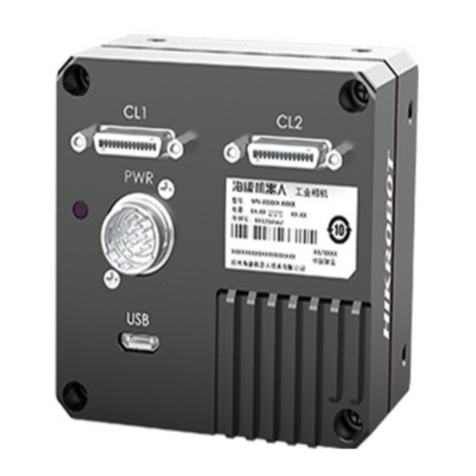
HikRobot
HikRobot MV-CL042-91CM User manual
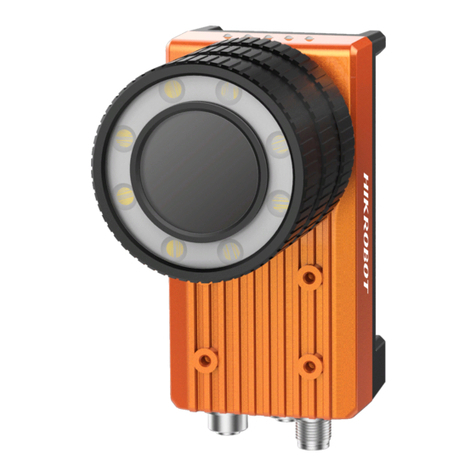
HikRobot
HikRobot X86 User manual
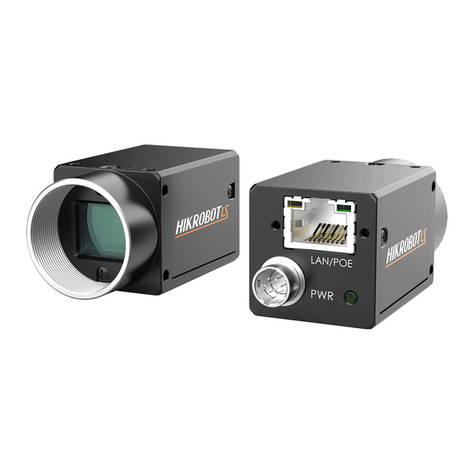
HikRobot
HikRobot GigE User manual
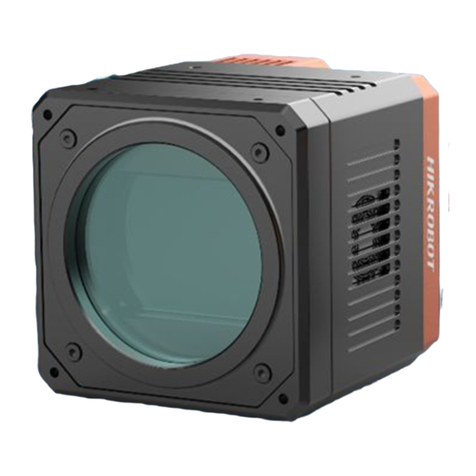
HikRobot
HikRobot CoaXPress User manual
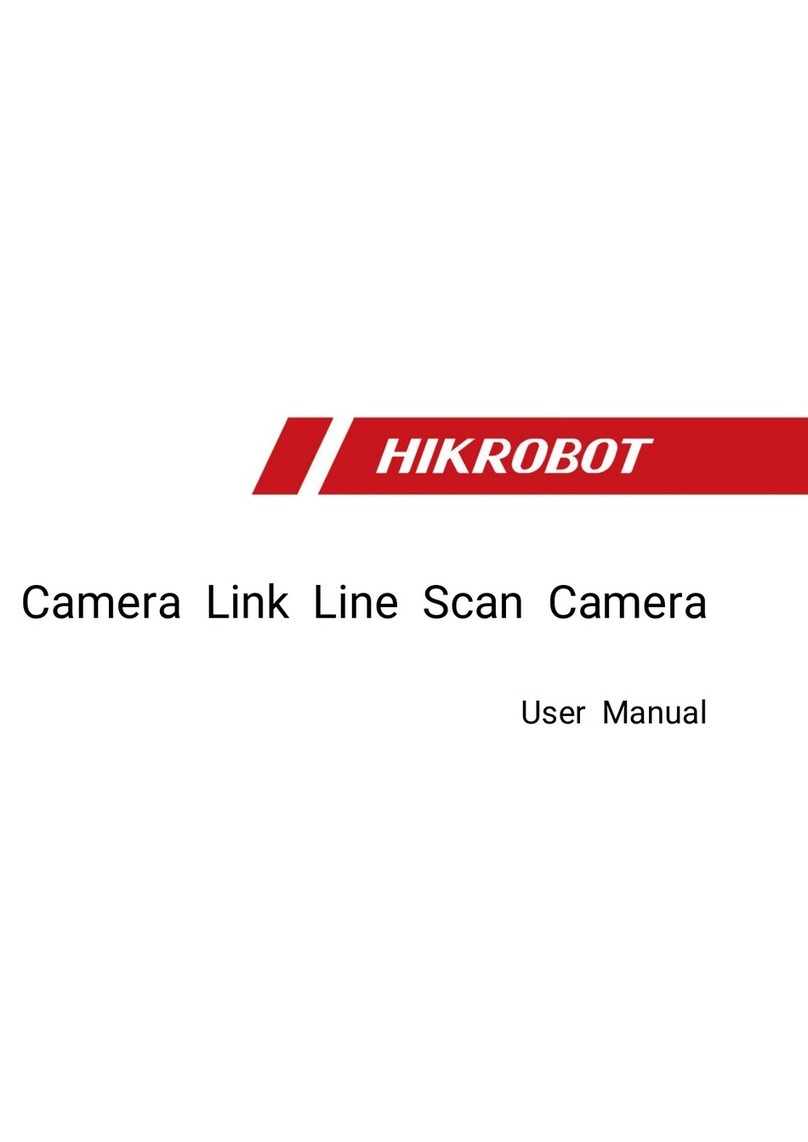
HikRobot
HikRobot MV-CL042-91CM User manual
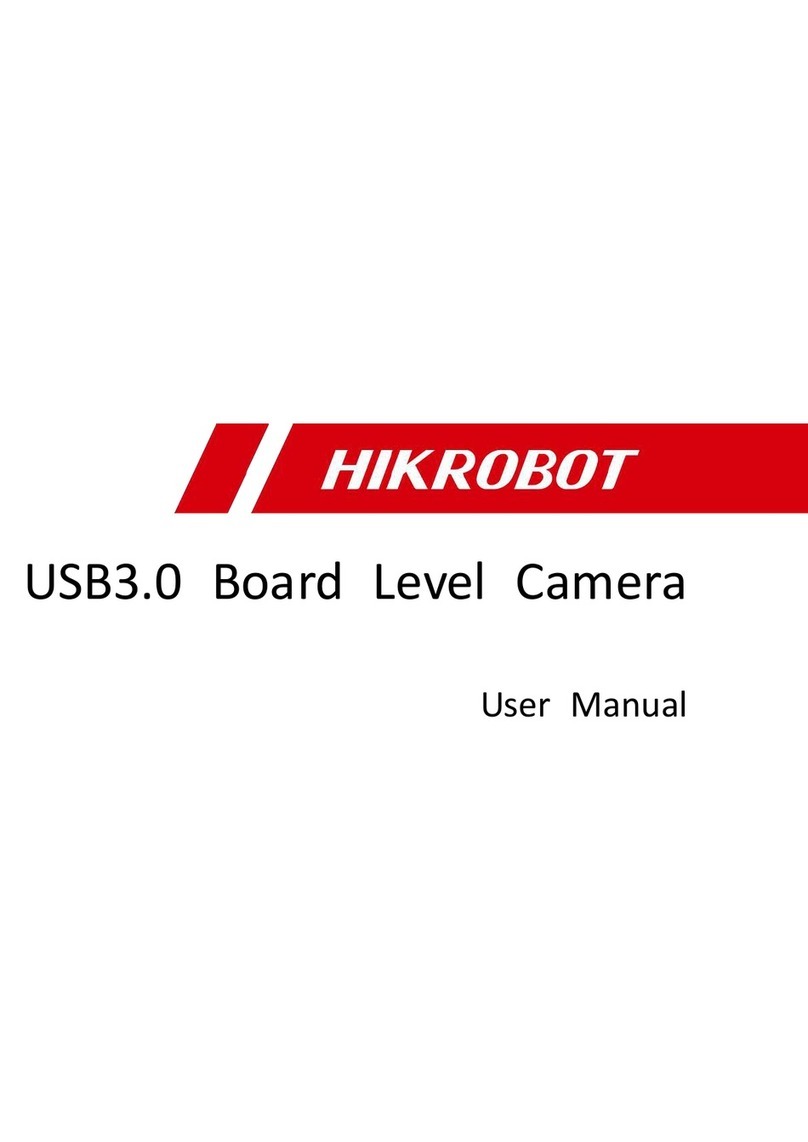
HikRobot
HikRobot USB3.0 User manual
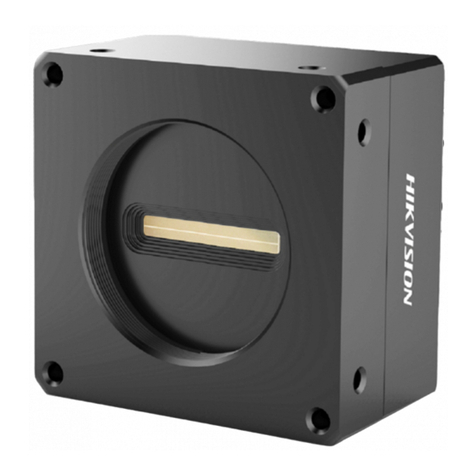
HikRobot
HikRobot MV-CL021-40GM User manual
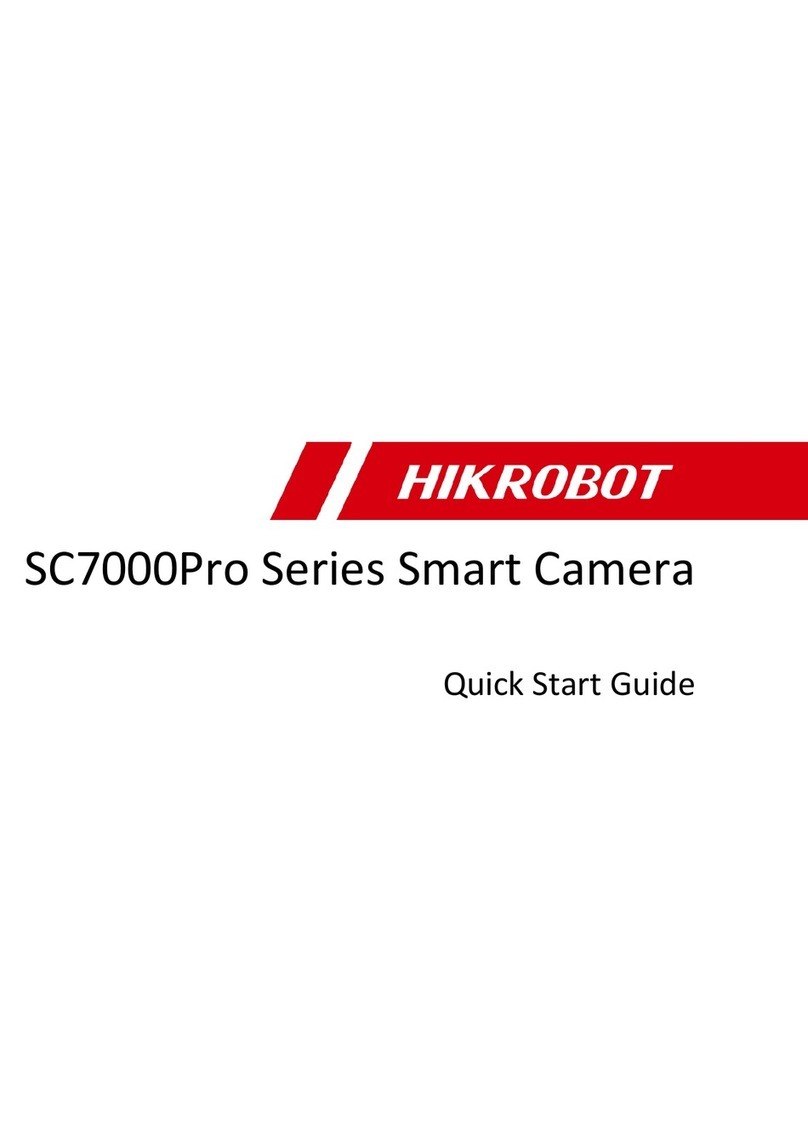
HikRobot
HikRobot SC7000Pro Series User manual
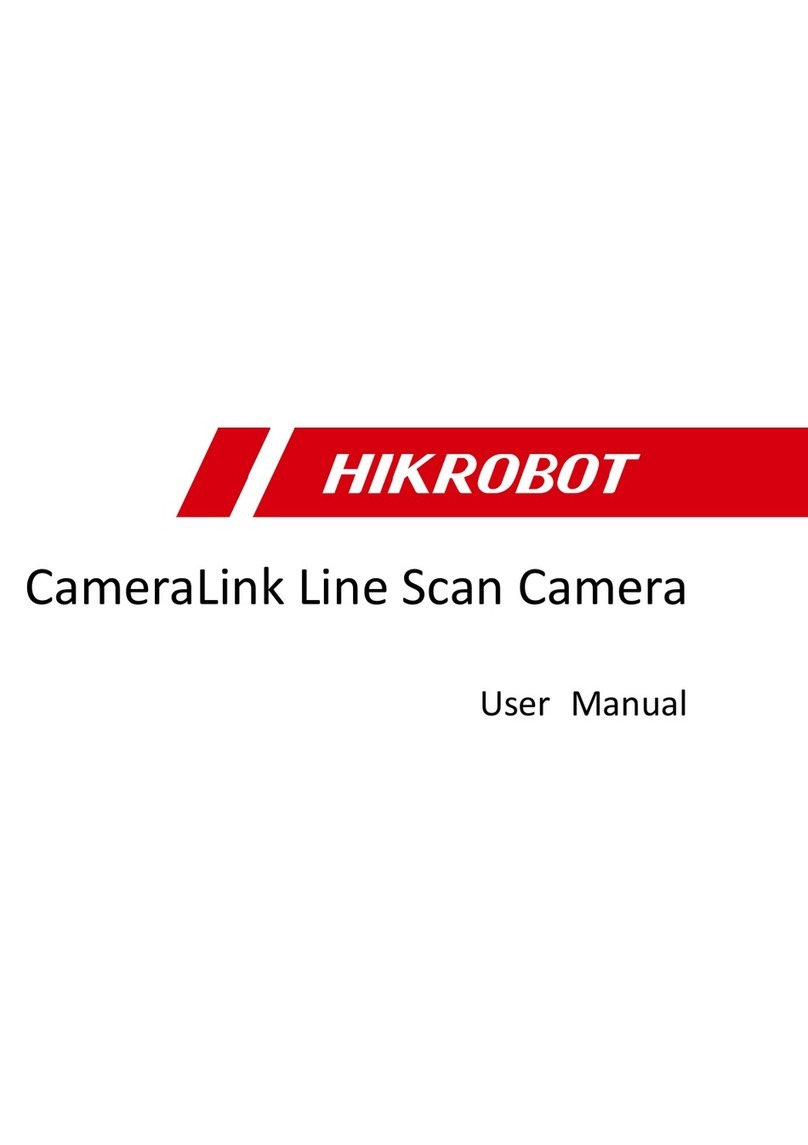
HikRobot
HikRobot CameraLink User manual
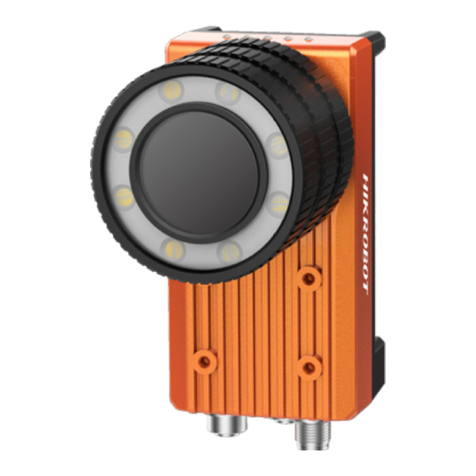
HikRobot
HikRobot X86 User manual


